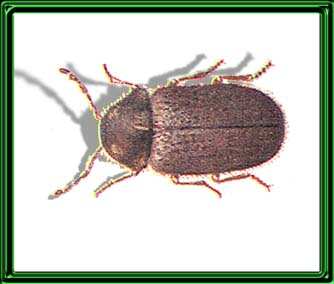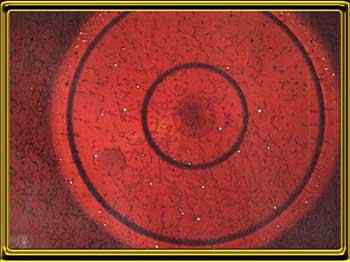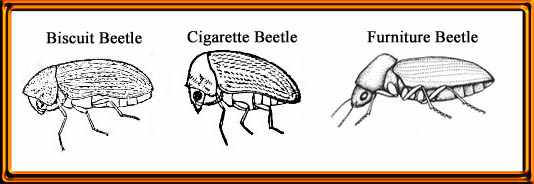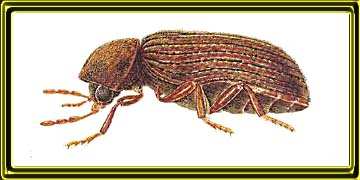
(Drugstore or Biscuit Beetle)
This is actually a member of the same family as that of the furniture beetle and tobacco beetle and that is Anobiidae. This has as it's members The furniture beetle and the the cigarette beetle plus a few others. To distinguish between the furniture beetle (otherwise known as woodworm) and the biscuit beetle is quite difficult, this is why I am mentioning woodworm on the stored product page. If you refer to the picture below, you will see that the main differences are the 'monks cowl' which covers the head of the insect.
A more pictorial side-view
The biscuit beetle has become adapted to a diet of starch-containing foods, and the round exit holes made by the larvae of this insect are exactly like the holes in timber made by the furniture beetle. The species has become distributed to all parts of the world. In fact, these beetles must have been spread by ships in former times, and the old habit of banging the ship's biscuits on the table before eating them perhaps served to drive out the beetle larvae. See the picture below of a ship's biscuit with the emergence holes:
Drugstore beetle larvae, like those of the wood boring beetle,
live inside their food and only emerge as adults.Some Biology:
Coleoptera: Anobiidae, Stegobium paniceum
Size: About 1/10 to 1/8 inch (2-3 mm)
Colour: Reddish/Brown
Description: The drugstore beetle is similar to the cigarette beetle and the furniture beetle in appearance but is slightly larger, more elongate, and has distinctly striated wing covers. The head is deflexed, but does not result in a distinct humpbacked appearance, and the antennae have three enlarged segments at the tip. The eggs of the biscuit beetle are pearly white, and are not easily seen with the naked eye. When fully grown, the larvae are C-shaped (grub-like) and about 3/16-inch long. The larvae can penetrate food packaging. Cigarette beetle larvae are creamy white and covered with long, yellowish-brown hairs. They have a brown head and legs. Drugstore beetle larvae are similar but do not have the fuzzy appearance. The life cycle lasts 3-7 months.
The last three segments of the antennae are like a saw. Its food is even more varied than that of the cigarette beetle, and it is said to feed "upon almost anything except cast iron."
Life cycle: Female drugstore beetles lay eggs singly in foodstuffs. The larval period ranges from 4 to 5 months, with the pupal stage lasting from 12 to 18 days. The complete life cycle requires 7 months. Larvae form a little round ball or cell which becomes its cocoon, and in which it pupates. Some have succeeded in rearing the beetle from egg to larvae in 2 months, with 4 broods per year in warm summer months. In cool climates, there is one generation per year.
Type of Damage and Habitat: True to their name, drugstore/biscuit beetles feed on many drugs in the pharmacy, such as laxative teas and even strychnine. They also infest almonds, peanuts, paprika, red pepper, alfalfa meal, cornmeal, flour, milo, wheat, wheat bran, wheat germ, dry dog and cat food, bread, birdseed, beans, coffee beans, fish meal, spaghetti, instant chocolate, powdered milk, books, manuscripts, dried flowers, certain fillers and fabric coverings of furniture, leather, museum specimens, and other foodstuffs.

A pattern of tunnels and holes in the bottom of a plastic bucket
made by the larvae of the Drugstore beetle. The bucket had been filled
with powdered soup in which the larvae had developed.
Control: Control of this pantry pest begins with the location of the infested food. A thorough clean up, using a vacuum cleaner to get into the cracks and crevices, will control this pest. Also be aware that if there are any bread items which have been varnished and used for display purposes in the kitchen, that these will be an ideal harbourage area.
Again in an industrial situation, things should not have got to the point where there is a problem, vigilance at all times, and scrupulous housekeeping is the only way to maintain a pest free environment.
Back to main Stored Product Insect page


